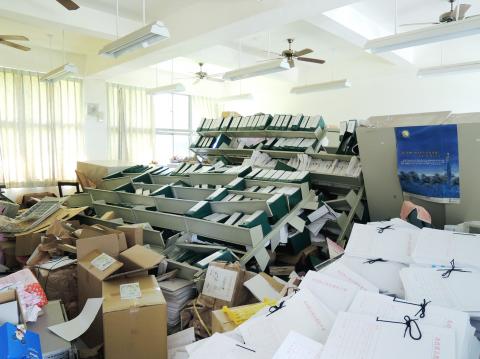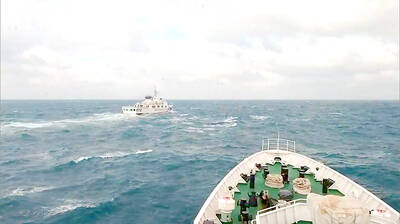The death toll from the magnitude 6.3 earthquake that rattled the nation on Sunday rose to four yesterday after two more victims were confirmed dead, the Central Emergency Operation Center said.
On Sunday, the center said that a 54-year-old man, surnamed Liu (劉), and a 50-year-old man, surnamed Hsiao (蕭), were killed by falling rocks in Chiayi County and Nantou County’s Shueili Township (水里) respectively.
The center said that a 69-year-old man, surnamed Liang (梁), and a 35-year-old man, surnamed Yang (楊), were also killed as a result of the earthquake.

Photo: Hsieh Chieh-yu, Taipei Times
Liang was reportedly hit by falling rocks while traveling in Nantou County’s Lugu Township (鹿谷).
He was pronounced dead early yesterday morning.
Yang was fishing in a river in Jhushan Township (竹山) when the earthquake struck.
Rescuers first found his backpack and other personal belongings yesterday morning and his body in the debris at 12:16pm.
As of 5pm yesterday, four people had been confirmed dead and 19 were injured by the earthquake.
Meanwhile, about 50 residents trapped in Dili Village (地利) in Nantou County’s Sinyi Township (信義) were able to leave the area after the Directorate-General of Highways cleared part of the Dili section of Highway 16 yesterday afternoon.
The Ministry of Education said that 160 schools were damaged by the earthquake, with estimated losses exceeding NT$12.35 million (US$410,000).
Lugu Junior High School in Nantou County, which was rebuilt after the 921 Earthquake in 1999, was closed yesterday due to severe damage.
However, many students and teachers voluntarily returned to the school to clean up the debris.
“All our wonderful memories are on this campus. I really wanted to graduate from here,” a female student said in tears.
Seismology experts cautioned that more earthquakes exceeding magnitude 6 could occur in Nantou County in the next few months.
“The epicenters of the magnitude 6.2 earthquake on March 27 and the one on Sunday were only about 4.2km apart,” Central Weather Bureau Seismology Center director Kuo Kai-wen (郭鎧紋) said. “The causes of these two earthquakes were very similar as well.”
Though the 921 Earthquake and Sunday’s earthquake happened on different fault lines, the bureau said that the two quakes were related.
Hongey Chen (陳宏宇), a professor of geology at National Taiwan University, said that a number of earthquakes since the 921 Earthquake had created of a decollement zone, a boundary separating deformed strata from underlying strata which are not similarly deformed.
“The energy generated by the compression of the Philippine Sea Plate and the Eurasian Plate has converged in this decollement [a gliding plane between two rock masses] zone,” Chen said.
Meanwhile, the Interchange Association, Japan, said its Taipei Office Director Sumio Tarui has extended his condolences to the families of the victims.
Tarui sent a letter to Association of East Asian Relations Chairman Lee Chia-chin (李嘉進) to express sympathy over the earthquake, the de facto Japanese consular office said in a statement yesterday.
Tarui also offered his best wishes for the speedy recovery of the injured, the Interchange Association said.
China has also expressed sympathy.
Taiwan Affairs Office spokeswoman Fan Liqing (范麗青) said that Chinese people were concerned about the deaths and damage caused by the quake.
“We send regards to the Taiwanese people affected by the temblor and extend condolences to the families of those killed in the earthquake,” Fan said.
“We hope that the residents of quake-affected areas can overcome the hardships caused by the disaster and resume their normal lives as soon as possible,” Fan said.
China is willing to lend a helping hand if Taiwan needs any assistance in its relief or rehabilitation efforts, she added.
Additional reporting by CNA

The Ministry of Foreign Affairs (MOFA) yesterday said it is closely monitoring developments in Venezuela, and would continue to cooperate with democratic allies and work together for regional and global security, stability, and prosperity. The remarks came after the US on Saturday launched a series of airstrikes in Venezuela and kidnapped Venezuelan President Nicolas Maduro, who was later flown to New York along with his wife. The pair face US charges related to drug trafficking and alleged cooperation with gangs designated as terrorist organizations. Maduro has denied the allegations. The ministry said that it is closely monitoring the political and economic situation

UNRELENTING: China attempted cyberattacks on Taiwan’s critical infrastructure 2.63 million times per day last year, up from 1.23 million in 2023, the NSB said China’s cyberarmy has long engaged in cyberattacks against Taiwan’s critical infrastructure, employing diverse and evolving tactics, the National Security Bureau (NSB) said yesterday, adding that cyberattacks on critical energy infrastructure last year increased 10-fold compared with the previous year. The NSB yesterday released a report titled Analysis on China’s Cyber Threats to Taiwan’s Critical Infrastructure in 2025, outlining the number of cyberattacks, major tactics and hacker groups. Taiwan’s national intelligence community identified a large number of cybersecurity incidents last year, the bureau said in a statement. China’s cyberarmy last year launched an average of 2.63 million intrusion attempts per day targeting Taiwan’s critical

‘SLICING METHOD’: In the event of a blockade, the China Coast Guard would intercept Taiwanese ships while its navy would seek to deter foreign intervention China’s military drills around Taiwan this week signaled potential strategies to cut the nation off from energy supplies and foreign military assistance, a US think tank report said. The Chinese People’s Liberation Army (PLA) conducted what it called “Justice Mission 2025” exercises from Monday to Tuesday in five maritime zones and airspace around Taiwan, calling them a warning to “Taiwanese independence” forces. In a report released on Wednesday, the Institute for the Study of War said the exercises effectively simulated blocking shipping routes to major port cities, including Kaohsiung, Keelung and Hualien. Taiwan would be highly vulnerable under such a blockade, because it

UNDER WAY: The contract for advanced sensor systems would be fulfilled in Florida, and is expected to be completed by June 2031, the Pentagon said Lockheed Martin has been given a contract involving foreign military sales to Taiwan to meet what Washington calls “an urgent operational need” of Taiwan’s air force, the Pentagon said on Wednesday. The contract has a ceiling value of US$328.5 million, with US$157.3 million in foreign military sales funds obligated at the time of award, the Pentagon said in a statement. “This contract provides for the procurement and delivery of 55 Infrared Search and Track Legion Enhanced Sensor Pods, processors, pod containers and processor containers required to meet the urgent operational need of the Taiwan air force,” it said. The contract’s work would be